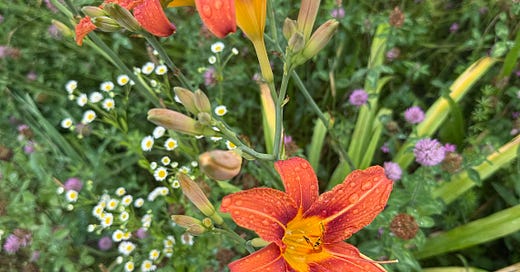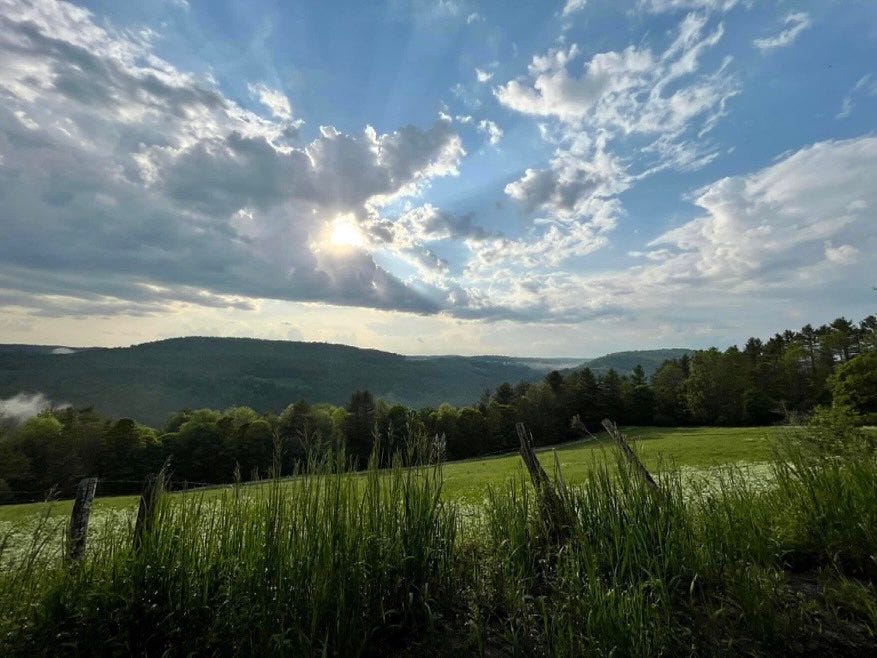You work so hard.
You are so productive.
All through autumn you harvest and can food and attempt to squeeze the last little green out of the fields. All through winter, you tend to your good little chores, your hearth work. We bring in wood and light the fires and dust the mantle and mend, mend, mend. When this good little way is through, we toil further in the workshops and craft rooms, building the scaffolding of whatever schemes we have for spring. Spring arrives and you fend off the predators and deal with the ravages of rain and wear all the way from the equinox straight through to the solstice. In July though? July shouts from the ditches and meadows that you stop, that you cease your toil for but a moment to simply view the riot of wildflowers and, for once in the year, engage in true, unadulterated leisure. July invites—nay, commands—leisure and its conduit is the prismatic display of the humble wildflower.
Why leisure?
Why not relaxation or contemplation or joy? We do not normally associate wildflowers with leisure. Beauty, romance, even pastoralism, yes. Not leisure though. This is an oversight, and to think on leisure—true leisure—in our contemporary culture is one of the last acts of actual transgression. Yes, you can be edgy and write out blasphemies, profanities, offensive and scathing diatribes. You can tear into every good old institution that has outlasted all the other rebels and luminaries before you. You can curse God and the devil too. All that is regular now however. Overly prescribed. It is the norm. To truly rebel, to truly commit an act of unbridled transgression against the contemporary culture that demands your constant productivity and constant consumption, that associates idleness with death all while blasting you with the siren song of neon content, you must stop. You must commit a bold act of leisure.
My dear friend
recently held a retreat with and others to investigate Josef Pieper's Leisure: The Basis of Culture. Pieper’s primary thesis as I understand it is that true culture is rooted in leisure, which he defines not as mere rest or idleness, but as a contemplative, receptive state of being that holds space for wonder, worship, and the pursuit of truth beyond utility. What can invite you to do this, to halt and deeply consider your surroundings, to wonder at creation, to find truth, more than a wildflower in July?Wandering in mid-July admiring the vibrant colors of flowers is a conduit for the leisure Pieper describes; it is a contemplative act where you are not producing or consuming but rather actively receiving the beauty of nature.
You are an open witness.
This openness to the natural glory of a wildflower in July, unburdened by the utility for which our wounded modern world so often screeches, enables you to begin to wonder at a sort of cultural richness. There in the meadow, amid the fleeting blooms of hot July, you begin to wonder, you begin to connect to timeless truths.
This essay is not a true investigation into Pieper’s work, but rather a reflection on what truths about leisure we may derive from July’s good flora as we wonder and wander there in the meadow. First, we become witness to beauty’s intrinsic value. We so often ask “What is this thing’s purpose?” but the vivid colors of flowers in July reveal beauty as an end in and of itself, not a means to a utilitarian goal. The beauty evokes virtues. The soft colors of young May and even June seem pale and anemic when placed besides July’s vital reds and oranges, its day lilies and its daisies, its maiden pink and milkweed. The naturalist Hal Borland wrote that July’s color were “an expression of summer at its prime, fiery with sunlight, vicious with lightning, surging toward maturity.” When you walk through a meadow in July, you may allow yourself to be swept up by the vitality Borland speaks of here. You may, through a sort of mental discipline, allow yourself to be free of those intrusive thoughts that ask “What should I be doing?” and instead remark on how the ox-eye daisies, the bird vetch, black-eyed Susans embody life in its prime.
Is that not enough?
To stand among what is most alive, most radiant, most itself, and let it instruct you in the art of simply being? Let the riot of color silence the itch to optimize, to schedule, to tame. Let the flowers remind you that beauty alone justifies its place in the world. Let that be your starting point.
So often we are producing or consuming. So rarely are we receiving in a perceptive way. If we accept that the self-evident beauty of a wildflower justifies its own place in the world simply by being, we have engaged in the uniquely human quality of receptivity. We have accomplished, acquired, enjoyed a bit of leisure in merely receiving this truth about the flower. Such leisurely contemplation, like observing nature, opens us to truths about our own place in the universe. I dare not suggest to you what these may be, but in the meadow of July, you may well find yourself contemplating your capacity for joy, reflection, your connection to something greater than yourself. This leisure enables the capacity for worship.
Dare we dream, there amid the riot of wildflowers, of lilies in July, that we are under the eternal auspices of a benevolent and loving god? Truly, such joyful musings—such bold hope—today is a transgressive act.
Indeed, a friend confessed recently that “There are things going on in the world that are genuinely not good. The adamant refusal, however, to acknowledge anything hopeful and to continue a narrative spiral of ‘everything is doomed’ has been extremely grating.” Our contemporary culture says your place in the modern world is a place of anger and despair. Your political leaders on both sides point to threats in the shadows, foreign fires, and problems they alone can solve. Meanwhile, the red orange riot of the lily in the ditch invites the contemplation of something greater than yourself and the contemporary woes. Its symmetry, its impossible red, its perfect form and promise of yet more blooms to come—all of this points to continuity, to eternity, to thoughts of something beyond you. Such observations transcend relaxation, transcend idle joy. Instead, it achieves a sort of active gratitude, a celebration of the transcendent. When you contemplate something as we have this flower, you are not mindlessly scrolling and being fed content; you are instead actively celebrating something true and beautiful. This leisurely contemplation does not cease at the good green borders of the natural world however. Indeed, it is merely the starting point, and when the contemplation transcends the good briar hedge, when it invites you to cease being busy, it opens the door for worship, a cornerstone of culture.
The pursuit of truth beyond utility begins in receptivity. It is not enough to actively look, you must be open and fighting against the urge to be doing something else, to be lured by something false. The wildflower of July is not an artifice, it is not manufactured, it is not an imitation. It simply is, and in its presence you remember what it means to receive something true. Our wounded modern world floods you with simulated wonders: digitized beauty, choreographed spontaneity, engineered joy. There is something in you that can always tell when you’re being scammed however, that gut instinct that senses when something is being offered to you with a catch.
You know it well.
Just the way synthetic vanilla tastes simultaneously flat and hollow, just the way certain smiles don’t reach the eyes, you just know when something is not quite right. The wildflower carries no such deceit. It is incapable. It is real, and so the reflections it invites too are real, true, enduring.
Simply standing before a flower in July, quiet, alert, unhurried, you become a witness to something older than every passing fad. Something ancient and simple and perennial. In that moment of silent acknowledgment, that reverent pause, you are achieving what Pieper called the basis of culture. You are contemplating what is. You are receiving a truth that cannot be repackaged or remade and cannot be experienced anywhere except in the context of the meadow in that moment. It is entirely localized. The way the light is dappled through the boughs, the way the breeze comes down from the hill, the insects that alight on the petal—this experience is unique to your local moment in time and cannot be replicated. In a world obsessed with not only novelty but so too safe global universal homogeneity, you are offered something eternal and specific to your land. You achieve leisure and become witness to the keystone, the central block of culture: tradition and locality.
This July, while the lilies still burn along the roadside and the meadows are still full, commit a bold act of leisure. Refuse, just for an afternoon, to be useful. Lay yourself down in a field if you can find one, or simply sit beneath the bluest patch of sky you can see and look, really look, at a single flower until you remember how to be a human being free of a greasy-ease machine. Let it stop you. Let it instruct you in silence and color and form. Let it reorder the disorder of the modern world from anemic grey-safe fleeting homogenous distraction to something vital, localized, perennial, true.
This is leisure.
This is culture.








I couldn’t agree more. The deepest beauty and mystery often reveal themselves in the quiet, overlooked moments that our rushed world so easily dismisses. If we silence our desires and open our hearts, we begin to truly experience life the way it was intended.
Write your book next winter if you can! It can sit next to Thoreau and Emerson on my bookshelf.